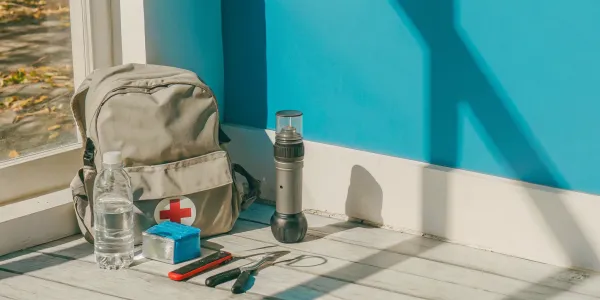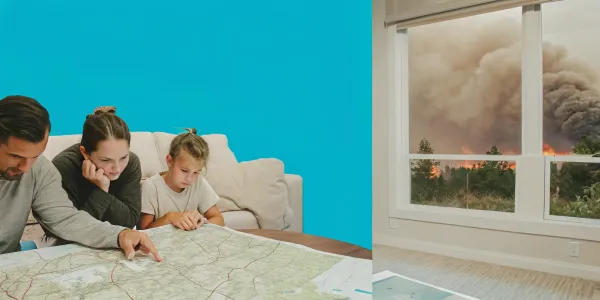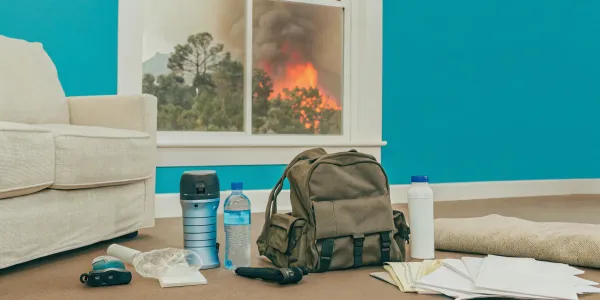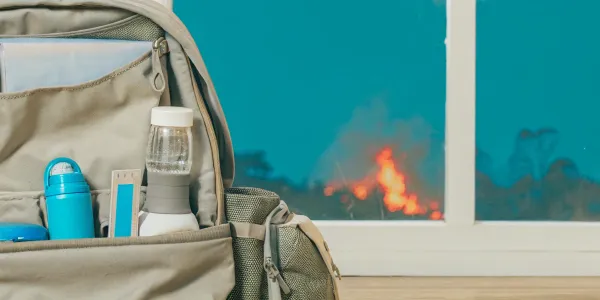What to Grab in a Fire Evacuation: Life-Saving Checklist
Know exactly what to grab in a fire evacuation. Use this life-saving checklist to prepare your go-bag, protect your family, and keep your essentials safe.
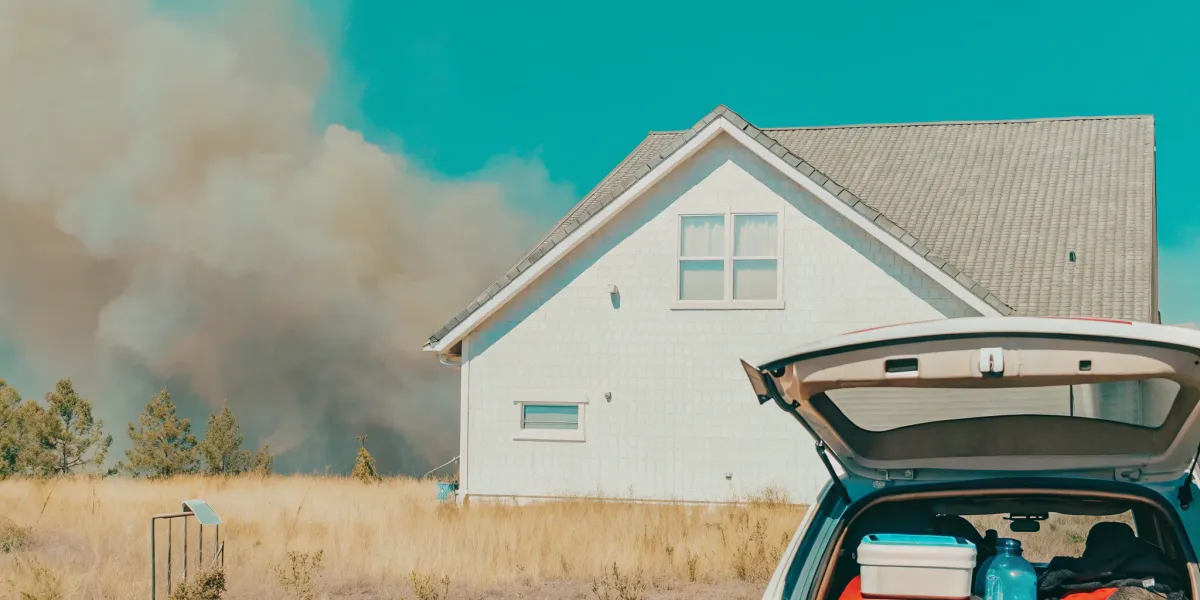
The moments after you evacuate are just as critical as the escape itself. Your focus shifts from immediate safety to the long road of recovery, and that journey begins with the items you brought with you. Having the right documents, medications, and contacts can make the difference between a smooth insurance claim and months of bureaucratic nightmares. Thinking about what to grab in a fire evacuation is about more than just food and water; it’s about packing the tools to rebuild your life. This article provides a comprehensive checklist for your go-bag, ensuring you have everything you need to stay safe, healthy, and prepared for what comes next.
Key Takeaways
- Pack for the Evacuation and the Aftermath: A complete go-bag goes beyond food and water. It must include a week's supply of medications, copies of essential documents, and pet supplies to manage your family's immediate safety and long-term recovery.
- Create Plans for When Technology Fails: Your family's safety depends on a simple, pre-agreed strategy. Designate an out-of-state contact for check-ins, set two physical meeting spots, and practice your home escape routes so everyone knows what to do without a phone.
- Make Your Plan Actionable, Not Just a Document: A plan is useless if it's outdated or you can't find your supplies. Store go-bags where you can grab them instantly and schedule twice-yearly drills to update supplies and practice your response.
Build Your Evacuation Go-Bag: The Essentials
When a wildfire threatens your home, you won’t have time to search for your wallet or sort through the medicine cabinet. An evacuation order means you need to leave immediately. Having a well-stocked “go-bag” ready for every member of your household is one of the most important steps you can take to protect your family. This kit ensures your essential needs are met for at least 72 hours after leaving home. Think of it as your lifeline, containing everything you need to stay safe, healthy, and informed during a stressful and uncertain time. Building your kit now gives you peace of mind and control when it matters most.
Plan for a 15-Minute Evacuation
In a fast-moving wildfire, you may only have 15 minutes—or less—to get out. In that scenario, your only priority is getting your family and pets to safety. There is no time to pack. This is why having a go-bag is not just a suggestion; it’s a critical part of your safety strategy. Your bag should be stored in a cool, accessible place like a hall closet or garage, where you can grab it without a second thought. A complete wildfire action plan goes beyond just packing a bag; it maps out your escape routes and communication strategy, ensuring everyone in your household knows exactly what to do when seconds count.
Pack Water and Non-Perishable Food
If you’re displaced from your home, you can’t count on stores being open or accessible. Your go-bag must contain enough food and water to sustain your family for at least three days. The standard recommendation is one gallon of water per person, per day. For food, choose non-perishable items that require no cooking or refrigeration, like protein bars, dried fruit, nuts, and canned goods. If you pack canned food, don’t forget a manual can opener. It’s also a good idea to rotate these supplies every six months to ensure everything stays fresh and ready for use.
Gather First-Aid and Medical Supplies
Your health needs don’t stop during an emergency. Pack a complete first-aid kit to handle minor injuries, including antiseptic wipes, bandages, gauze, and medical tape. More importantly, include a seven-day supply of any prescription medications for your family members and pets. Getting a refill can be nearly impossible during a disaster. Also, pack copies of your prescriptions, extra eyeglasses or contact lenses, and any necessary medical equipment. You can buy a pre-made kit and customize it with your family’s specific needs, following guidelines from organizations like the American Red Cross.
Include Essential Tools and Safety Gear
Power outages and poor visibility are common during wildfires. Your kit should include tools to help you stay safe and informed. Pack a flashlight, a battery-powered or hand-crank radio, and plenty of extra batteries. The radio will allow you to receive emergency broadcasts even if cell service is down. A multi-tool, work gloves, and N95 masks to protect your lungs from smoke are also essential. These simple tools can make a huge difference in your ability to handle unexpected challenges. For a comprehensive list, you can reference CAL FIRE’s emergency supply kit checklist.
Add Personal Hygiene Items
Staying clean can have a big impact on your health and morale during a stressful evacuation. Pack travel-sized personal hygiene items for everyone in the family. This includes toothbrushes, toothpaste, soap, deodorant, and any necessary feminine hygiene products. A pack of sanitation wipes is incredibly useful for quick clean-ups when you don’t have access to running water. Also include a roll of toilet paper and a small towel. These small comforts can help you and your family feel more normal and cared for while you’re away from home, reducing stress in a difficult situation.
Secure Your Critical Documents and Digital Files
When an evacuation order comes, you won’t have time to search for paperwork. The documents that prove your identity, ownership, and insurance coverage are the foundation of your recovery after a wildfire. Losing them can create months of bureaucratic delays just when you need support the most. Gathering these items ahead of time is one of the most critical steps in your emergency plan.
Think of it this way: your go-bag helps you survive the evacuation, but your documents help you rebuild your life afterward. You’ll need them to file insurance claims, apply for disaster assistance, and even enroll your kids in a new school. Storing physical copies in a fireproof, waterproof bag is a great start, but it’s not enough. A complete wildfire action plan includes digital backups stored securely in the cloud, ensuring you can access them from anywhere, even if the originals are lost. Taking an hour now to organize these files will save you immense stress and uncertainty later.
Copies of Personal IDs
Your personal identification is non-negotiable. Without it, simple tasks like checking into a hotel or accessing financial accounts become incredibly difficult. Your go-bag should contain physical copies of your driver’s license, passport, and any other government-issued IDs. Also include copies of birth certificates, Social Security cards, and marriage or divorce papers. These documents are essential for verifying your identity and family relationships when applying for aid. Keep these copies in a waterproof pouch within your evacuation kit. For added security, scan these documents and save them to a password-protected cloud account.
Key Financial and Insurance Papers
After a fire, your financial stability depends on having access to key documents. Pack copies of your bank account information, credit and debit cards (or at least the numbers and contact info), and recent pay stubs. Most importantly, include a complete copy of your home and auto insurance policies. This document is your roadmap for filing a claim and understanding your coverage. Having the policy number and your agent’s contact information readily available will allow you to start the recovery process immediately, which is a critical first step toward getting back on your feet.
Important Medical Records
During the stress of an evacuation, the last thing you need is a medical emergency. Pack your health insurance cards, a list of your prescription medications (including dosages), and contact information for your doctors and pharmacy. If you or a family member has a complex medical condition, include a summary of the diagnosis and treatment plan. Don’t forget practical items like prescription glasses, contact lenses, and solution. Having these medical essentials on hand ensures you can manage your health without interruption while you’re away from home. You can find more tips for your kit on the Ready.gov preparedness site.
Home and Vehicle Titles
Proving ownership of your largest assets is crucial for insurance claims and federal disaster assistance. Your evacuation kit should include copies of the deeds or titles to your home, vehicles, and any other major properties. These legal documents are the official proof of what you own. While originals are best kept in a safe deposit box, having accessible copies can speed up the recovery process significantly. Without them, you could face long and frustrating delays while trying to verify ownership with government agencies and your insurance carrier.
Create Digital Backups
Physical documents can be lost or destroyed. Your best defense is a robust digital backup system. Before an emergency strikes, take the time to scan all your critical documents—IDs, insurance policies, financial records, property titles, and even family photos. Save these files to a secure cloud service like Dropbox or Google Drive and consider keeping a copy on a password-protected external hard drive that you store off-site or in your go-bag. This simple step ensures that even if the worst happens, your most important information is safe and accessible from any computer or smartphone.
Pack for Every Member of the Family (Pets, Too)
When an evacuation order comes, your focus narrows to one thing: getting your loved ones to safety. But every member of your household has unique needs, from the youngest to the oldest, including the four-legged ones. Thinking through these specific needs now means you won’t be scrambling to remember critical items in a high-stress moment. A well-prepared plan ensures that everyone’s essentials are packed and ready, providing not just physical supplies but also a sense of security when it matters most.
What Your Kids Will Need
Evacuating is scary for children. Packing familiar items can make a huge difference in easing their anxiety. Alongside a week’s worth of clothing and basic toiletries, include a few things that feel like home. This could be their favorite book, a small stuffed animal, or a comforting blanket. If you have infants, pack diapers, wipes, formula, and bottles. For older kids, consider a portable game, a book, or a journal and pen to help them process what’s happening. Having these small comforts can provide a much-needed distraction and a sense of normalcy during a chaotic time.
Supplies for Older Adults
If you have older adults in your household, their needs should be a central part of your evacuation plan. Pack any mobility aids they rely on, like a cane or walker, and ensure you have extra batteries for hearing aids or other medical devices. It’s also critical to assign a specific person to assist them during an evacuation drill and in a real emergency. This ensures they are not left behind in the rush. Your family’s home fire escape plan should clearly outline who is responsible for helping whom, so everyone gets out safely and with the equipment they need.
Prepare a Pet Go-Bag
Your pets are family, and they need their own go-bag. Many emergency shelters cannot accept pets, so you need a plan and the supplies to care for them. Your pet’s kit should include at least a week’s worth of food and water, bowls, and any medications they take. Don’t forget a sturdy leash, harness, and a carrier for safe transport. For cats, include a small litter box and litter. It’s also wise to pack a copy of their vaccination records, a current photo in case you get separated, and a favorite toy for comfort.
Pack Medications and Medical Equipment
This is one of the most critical parts of your go-bag. Forgetting essential medication can turn a stressful situation into a medical emergency. Pack at least a one-week supply of all prescription medications for every family member. Create a waterproof list that includes each person’s medications, dosages, prescribing doctor, and pharmacy information. Don’t forget over-the-counter basics like pain relievers and allergy medicine. If anyone uses glasses or contacts, pack spares along with contact solution. Also include any necessary medical equipment, like a glucose meter or blood pressure monitor.
Add Items for Comfort and Stress Relief
An evacuation is emotionally draining for everyone. Packing a few small items for comfort can help manage stress and pass the time if you end up at a shelter or hotel. Think about what helps your family relax. This could be a deck of cards, headphones and a power bank for listening to music, a good book, or a journal. These items don’t take up much space but can provide a welcome distraction and a small piece of normalcy. The official CAL FIRE emergency supply kit guide recommends including these personal items to help your family cope during a difficult time.
Organize Your Kits for Quick Access
Having a well-stocked evacuation kit is a great first step, but it won’t help if you can’t find it when alarms are blaring and you have minutes to leave. Organizing your supplies for immediate access is just as critical as packing them. When every second counts, you need a system that works without a moment’s thought.
Choose the Right Storage Location
Where you store your Go-Bag can make all the difference. The goal is to place it somewhere you can grab it on your way out the door without thinking twice. A front hall closet, the mudroom, or right inside the garage are all excellent choices. The key is to ensure your kit is in a spot you’ll pass during a quick escape. Avoid stashing it in the back of a cluttered attic or a basement that might be hard to access. Think about your most likely exit route and place your kit there.
Keep an Emergency Kit in Your Car
You might not be home when an evacuation order is issued. That’s why it’s smart to keep a dedicated emergency kit in your car. This kit serves as a critical backup if you’re at work, running errands, or forced to leave your home without your main Go-Bag. Your car kit should include essentials like water, non-perishable food, a first-aid kit, blankets, and a phone charger. Ready.gov offers a great guide to help you build a kit specifically for your vehicle, ensuring you’re prepared no matter where you are.
Use Grab-and-Go Bags or Bins
When you need to evacuate, you want supplies that are easy to carry. Pack your items in sturdy backpacks to keep your hands free for opening doors, carrying children, or managing pets. For larger family supplies or items from your "stay-at-home" kit, use durable plastic bins with secure lids. This makes it simple to load your car quickly and efficiently. An effective evacuation packing list considers not just what you pack, but how you pack it for mobility.
Check and Update Your Kits Regularly
Your family’s needs change over time, and your emergency kits should, too. Set a reminder on your calendar—perhaps at the start of fire season or on New Year's Day—to review your supplies. Check expiration dates on food, water, and medications. Swap out clothes that your children have outgrown, test your batteries, and make sure your documents are current. It’s important to update it as your family’s needs change to ensure your kit is always ready to go when you are.
Prepare for a Nighttime Evacuation
Wildfires don’t wait for convenient hours. An evacuation order can come in the middle of the night, when you’re disoriented and it’s dark. To prepare, always keep a pair of sturdy, closed-toe shoes and a flashlight right by your bed. If you wear glasses, keep them on your nightstand. These simple preparations ensure you’re ready if you need to leave suddenly in the dark, removing small but critical obstacles that could slow you down.
Plan for Valuables and Sentimental Items
When an evacuation order comes, your priority is getting your family to safety. But the thought of leaving behind irreplaceable items—family photos, heirlooms, critical documents—is heartbreaking. The stress of a real emergency is not the time to decide what to save. Planning ahead is the only way to protect these items without compromising your safety. By thinking through what matters most and organizing it for a quick departure, you can save precious memories and vital records. This process involves identifying what's truly irreplaceable, creating digital backups, and having a tiered plan for what to grab based on how much time you have. A clear strategy removes the guesswork and panic, letting you focus on what's important: a safe evacuation.
Digitize Important Documents
Your most important papers—passports, birth certificates, Social Security cards, property deeds, and insurance policies—are a nightmare to replace. Don't risk losing them. The best defense is to digitize them now. Scan or take clear photos of every critical document and save them to a secure, password-protected cloud service like Dropbox or Google Drive. For an extra layer of security, keep a copy on an encrypted USB drive that you store in your go-bag or a safe deposit box. This ensures you have access to vital information needed for recovery efforts, even if the original papers are destroyed. The Federal Emergency Management Agency (FEMA) provides excellent guidance on safeguarding these records before a disaster strikes.
Save Family Photos
Physical photos are often the first thing people regret losing. While you can't grab every album in an emergency, you can protect the memories they hold. Your primary strategy should be digitization. Take the time to scan old family photos or use a professional scanning service. Store these digital copies in the cloud and on an external hard drive, just like your documents. For the most cherished physical prints, designate one small, sturdy, and portable photo box. Keep it somewhere accessible, so it can be grabbed quickly if there’s time. This small step ensures your family’s visual history isn't lost.
Identify Irreplaceable Heirlooms
Every family has items whose value isn't monetary but sentimental. It could be your grandmother’s wedding ring, a child’s first drawing, or a family Bible. In the heat of an evacuation, you won't have time to search for them. Sit down with your family and make a list of these truly irreplaceable items. For small things like jewelry, consider storing them in your fireproof safe or go-bag ahead of time. For larger items, take high-quality photos and write down their history. This documentation is crucial for insurance purposes and for preserving the memory, even if the item itself is lost.
Make a "If There's Time" List
Evacuation warnings can range from minutes to hours. A tiered plan helps you adapt. Your go-bags cover the "get out now" scenario. For situations with more warning, create an "if there's time" list. This is a prioritized checklist of additional items to grab, like the photo box, a specific piece of art, or your work laptop. Keep the list with your go-bags or taped to the inside of a closet door. Knowing exactly what to grab next prevents frantic, last-minute decisions. This kind of detailed preparation is a core part of a strong Wildfire Action Plan, turning chaos into a calm, methodical process.
Create Your Family Communication Plan
When an evacuation order comes, chaos can set in quickly. Roads get jammed, cell towers become overwhelmed, and power can go out. In the confusion, it’s easy to get separated from your family. Assuming you’ll be able to call each other is a dangerous mistake. A solid communication plan is just as critical as your go-bag because it answers the most important question: Is everyone safe?
This isn’t about complex technology; it’s about having simple, pre-arranged agreements that work even when technology fails. Your plan should clearly outline how you’ll get in touch, who you’ll check in with, and where you’ll meet if you’re separated. Everyone in your household, from young children to older adults, needs to understand the plan. Walking through it together before a disaster strikes removes the panic and guesswork, allowing everyone to act decisively. A well-rehearsed plan ensures that your first priority—the safety of your loved ones—is secured, letting you focus on getting out quickly.
Decide How You'll Contact Each Other
During an emergency, cell networks are often the first thing to fail. While a phone call might not go through, a text message often can, as it requires much less bandwidth. Make texting your primary method of communication. Your backup plan should be an out-of-state contact. Choose a relative or friend who lives in a different part of the country to act as your family’s central point of contact. It’s often easier to make a long-distance call than a local one during a regional disaster. After evacuating, each family member should call or text this person to report that they are safe. This creates a simple, central hub for information when direct communication is impossible.
Make an Emergency Contact List
You can’t rely on the contact list stored in your phone, which could be lost, damaged, or out of battery. Create a physical, waterproof list of essential phone numbers and email addresses for every member of your family. Include numbers for your out-of-state contact, family members, doctors, schools, and your insurance agent. Keep a copy in each person’s go-bag, in your car’s glove compartment, and at your workplace. It’s also smart to have a digital version saved in the cloud or emailed to yourself. Make sure everyone, including older children, knows where to find this list and understands who to call first.
Know Your Local Emergency Alerts
Misinformation spreads fast during a crisis. It’s vital to know where to get timely and accurate updates from official sources. Before an emergency, identify your county’s office of emergency services and your local fire and police departments. Follow their social media accounts and bookmark their websites. Find out which local radio and TV stations are designated for emergency broadcasts. Relying on these trusted sources for information on evacuation orders, road closures, and shelter locations will help you make a plan based on facts, not fear. Knowing where to turn for reliable information is a key part of staying safe.
Designate Safe Meeting Places
If your family is not together when an evacuation is ordered, you need pre-determined places to reunite. Choose two locations. The first should be right outside your home for a sudden emergency, like a fire in the house. This could be a specific spot like your mailbox or a neighbor’s driveway. Your second meeting place should be outside your neighborhood, in case you can’t get back to the area. This could be a library, a community center, or the home of a friend or relative. Make sure everyone knows the address of both locations and how to get there.
Sign Up for Emergency Notifications
The fastest way to receive an official evacuation warning is directly on your phone. Most counties have a free emergency alert system (sometimes called a reverse 911 system) that sends critical updates via text message or phone call. You must sign up for these alerts to receive them. Take a moment right now to search for your county’s emergency alert system and register every phone in your household. These notifications are your official signal to leave and can provide life-saving information on timing and safe evacuation routes. Don’t wait—this is one of the most important steps you can take to protect your family.
Map Out Your Home Evacuation Routes
When an evacuation order comes, you won’t have time to think. Panic and confusion can set in quickly, which is why a pre-planned and practiced evacuation route is one of the most critical parts of your family’s safety plan. This isn’t just about knowing where the front door is. It’s a detailed map that every person in your home understands, showing them how to get out of any room and where to meet safely. A clear plan removes the guesswork during a high-stress emergency, saving precious seconds that could make all the difference. Your goal is to create a simple, repeatable process that becomes second nature for everyone.
Know Your Primary Exits
The foundation of your home evacuation plan is identifying the main way out of every single room. Walk through your house and map out at least two exits for each room—typically a door and a window. Make sure everyone, including children, knows these routes by heart. The key is to keep these paths clear at all times. Hallways shouldn't be cluttered with boxes, and doors need to be easy to open. Establish a safe meeting spot outside, a safe distance from the house, like a specific tree or a neighbor’s mailbox. This ensures you can quickly account for everyone without re-entering a dangerous building.
Identify Secondary Escape Routes
Primary exits can easily become blocked by fire or smoke. That’s why every room needs a reliable backup escape route. For most rooms, this will be a window. Check every window to ensure it opens easily and isn't painted or swollen shut. For second-story rooms, you must have a way to get down safely. Invest in emergency escape ladders and store them near the window in each upstairs bedroom. Practice deploying them so everyone knows how they work. If you have security bars on your windows, make sure they have a quick-release mechanism that can be operated from the inside.
Locate Your Safety Equipment
Knowing your escape routes is only half the battle; you also need to know where your safety tools are. Make sure everyone in the family knows the location of fire extinguishers and how to use them. Test your smoke alarms monthly and change the batteries at least once a year. Your plan should also account for every family member's needs. Assign a specific person to assist infants, older adults, or anyone with mobility challenges. This ensures no one is left behind in the confusion. Having a clear home fire escape plan that includes these details is essential.
Assign "Quick-Grab" Items
In an evacuation, you'll only have minutes to leave. To avoid a frantic search for essentials, assign specific "quick-grab" items to each responsible person in the household. For example, one person grabs the "Go Bag" with documents and medical supplies, another is in charge of the pet carriers, and a third handles personal electronics and chargers. This division of labor makes your departure faster and more organized. Keep these items, especially your emergency kits, in a designated, accessible spot like a hall closet near an exit. This strategy is a core part of the Ready, Set, Go! wildfire preparedness model and helps ensure you leave with everything you need.
Avoid These Common Evacuation Mistakes
Creating an evacuation plan is a huge step toward protecting your family. But a plan on paper can fall apart in the chaos of a real emergency if it’s not built to withstand pressure. When an evacuation order comes, you’ll be dealing with stress, uncertainty, and a ticking clock. It’s in these moments that small oversights can become major problems. The difference between a smooth evacuation and a frantic scramble often comes down to avoiding a few common, but critical, mistakes.
Thinking through these potential pitfalls now, when you are calm and have time to prepare, is one of the most important things you can do. It’s not about imagining a worst-case scenario to create fear; it’s about building a resilient plan that works when you need it most. From forgetting life-saving supplies to having a communication plan that no one remembers, these are the gaps that can undermine your best efforts. Let’s walk through these common mistakes so you can be sure your plan is as solid and reliable as possible.
Forgetting Essential Supplies
In the rush of an evacuation, it’s easy to forget critical items. Relying on your memory during a high-stress event is a recipe for leaving behind essentials like prescription medications, chargers, or important documents. This is why having a pre-packed go-bag is non-negotiable. One of the most critical steps in preparing for a wildfire is having your supplies ready to go at a moment's notice. Your kit should be built with the assumption that you won't be able to return home for several days. Thinking through these needs ahead of time ensures you have what you need to stay safe and comfortable while you wait for the all-clear.
Storing Your Kit in the Wrong Place
You’ve packed the perfect go-bag—that’s great. But if it’s buried in the back of a closet or deep in the garage, it might as well not exist. Your emergency kit needs to be stored in a place that is incredibly easy to access on your way out the door. Think of a hall closet near your main exit or right inside the garage door next to your car. Some families keep a primary kit in the house and a smaller version in their vehicle. Not having an evacuation plan—or a kit you can actually grab—can lead to chaos during an emergency. Make it so easy to grab that you don't even have to think about it.
Having an Incomplete Communication Plan
A major oversight in many evacuation plans is a weak communication strategy. What happens if cell towers are down or overwhelmed? How will you connect with family members who aren't at home when the order comes? Your plan needs to account for these possibilities. Designate an out-of-state friend or relative as a central point of contact for everyone to check in with. Make sure everyone in your household has a physical list of important phone numbers and your designated meeting spots. A strong family communication plan ensures you can reunite quickly and confirm everyone is safe, which is the number one priority.
Not Practicing or Updating Your Plan
Failing to practice your evacuation plan can lead to confusion and panic during an actual emergency. A plan is just a document until you’ve walked through it. At least twice a year, run a drill with your family. Practice your evacuation routes and talk through each step. This is also the perfect time to check your go-bags for expired food, water, and medications, and to update your contact lists. Life changes—kids get older, you might get a new pet, or your neighbor who you planned to check on moves away. Your plan needs to reflect your current reality. You can use your Wildfire Action Plan to keep everything current and ensure your family is always prepared.
Related Articles
- Wildfire Car Emergency Kit: The Ultimate Checklist
- 5-Minute Evacuation Checklist: What to Grab Now
- The Essential 14-Day Emergency Kit List [Checklist]
Frequently Asked Questions
I feel overwhelmed by all this. What's the first thing I should do? Don't try to do everything at once. Start with one small, manageable task: pack a single bag with the absolute essentials. Focus on a three-day supply of water, some non-perishable snacks, any prescription medications you can't live without, and copies of your personal IDs. Completing that one bag is a huge step forward and will give you the momentum to tackle the rest of your plan.
How often do I really need to update my go-bag? It’s best to review your kits at least twice a year. A great way to remember is to tie it to a seasonal change, like when you change your clocks or at the official start of fire season. During your review, check the expiration dates on food, water, and medications, test the batteries in your flashlight and radio, and swap out any clothing that your kids may have outgrown.
What if my family gets separated during an evacuation? This is a common fear, and it’s why your communication plan is so critical. Before an emergency, agree on two specific meeting places: one just outside your home for a sudden event, and another outside your neighborhood in case you can't get back. Also, choose one out-of-state friend or relative to be your family's central point of contact. If you're separated, everyone knows to call or text that person to report they are safe.
Are digital copies of my documents really enough for insurance or government agencies? While a digital copy won't serve as a legal replacement for a physical driver's license or passport, it is an invaluable tool for your recovery. Having immediate access to account numbers, policy details, and proof of identity can dramatically speed up the process of filing insurance claims or applying for disaster assistance. Think of it as your essential backup if your original documents are lost or destroyed.
Besides the go-bag, what's the most common thing people forget? People often forget to plan for an evacuation that happens in the middle of the night. When you're woken from a deep sleep, it's easy to become disoriented. A simple but vital step is to always keep a pair of sturdy, closed-toe shoes and a flashlight right by your bed. This ensures you can get up and move safely and quickly, even in the dark.

